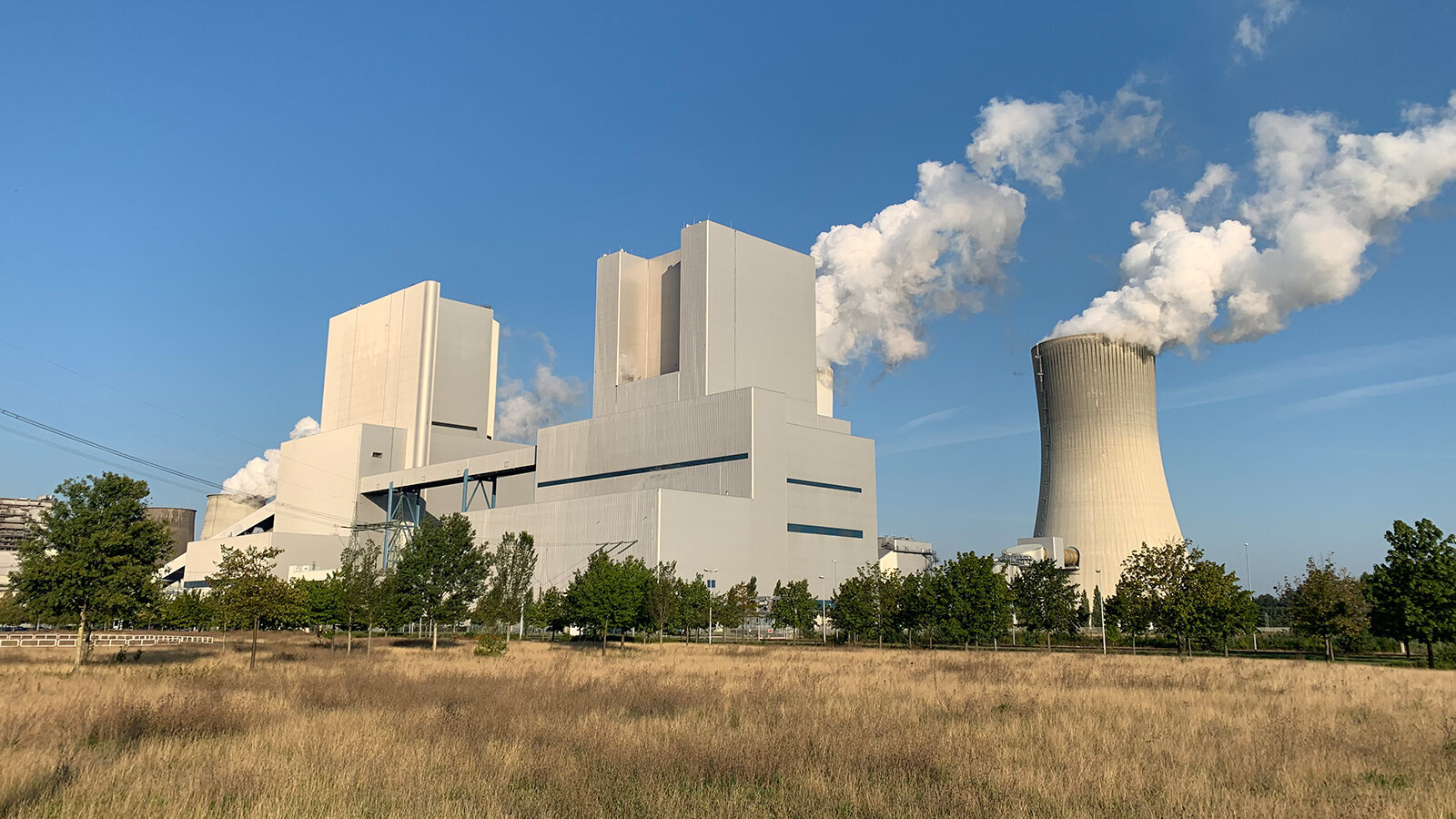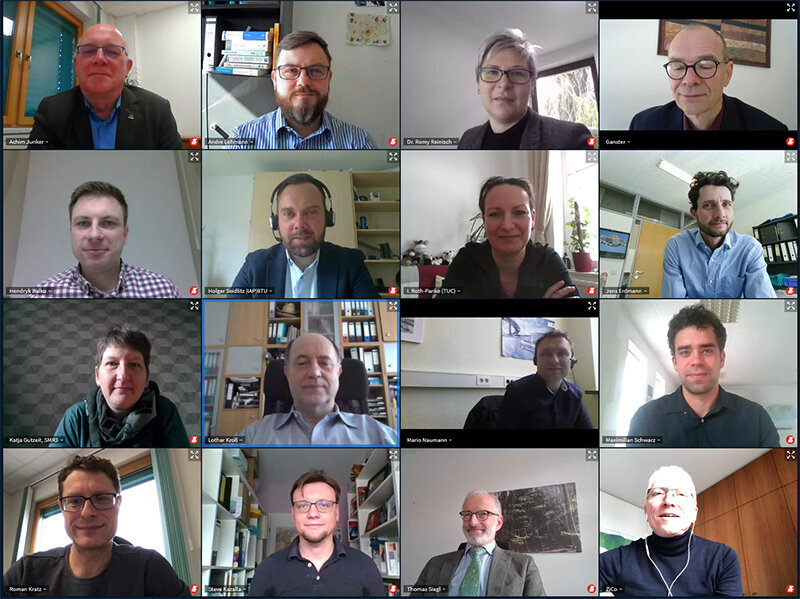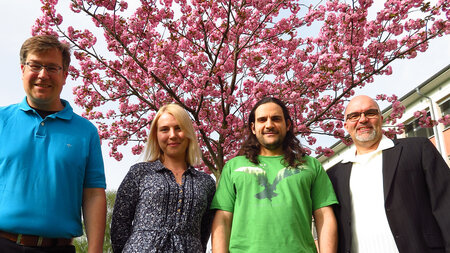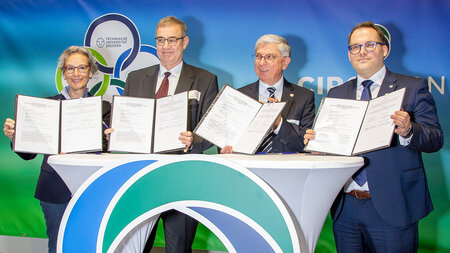Project on carbon fiber research "InnoCarbEnergy" has started
Digital kickoff meeting between Chemnitz University of Technology’s Cluster of Excellence MERGE, the Fraunhofer Institute for Machine Tools and Forming Technology IWU, and the Fraunhofer Institute for Applied Polymer Research IAP identified next steps for the cooperation project to research and develop "green" carbon fibers in Lusatia
-

At the LEAG power plant site in Boxberg/Upper Lusatia, the competencies of the cooperation partners will be bundled, and sustainable structural change will be set in motion. Image source: Saxon State Ministry for Regional Development -

On March 16 2021, the project started its first phase with a virtual kickoff meeting in the presence of representatives from all cooperating institutions. Scientists from Chemnitz University of Technology are also contributing their expertise to the ambitious project. Photo: Screenshot
On March 16 2021, the project "InnoCarbEnergy: Carbon, Systems, and Mobility Solutions SAXONY" started into its first phase with a virtual kickoff meeting. The project, which includes the Cluster of Excellence MERGE at Chemnitz University of Technology, is dedicated to the central question of how carbon fibers can be produced in a climate-friendly way on the basis of new chemical starting substances or “precursors”. Among other things, renewable and alternative raw materials such as cellulose or algae could come into use here. An additional goal of the project is the production of customized carbon fibers with product-specific properties that could generate a cost advantage of up to 30 percent compared with conventional manufacturing processes. At the same time, the effects of the ongoing coal phase-out are to be mitigated, and a sustainable structural change is to be set in motion by pooling the expertise of the cooperation partners at the LEAG power plant site in Boxberg.
Background: Why carbon fibers?
In addition to the coal phase-out, which is one of the most demanding challenges in recent decades, the transport revolution can make a significant contribution to achieving the environmental policy goals set forth in the "European Green Deal”. Alternative drive systems with batteries and hydrogen as sources of power are already providing promising solutions. An equivalent approach to reducing climate-damaging emissions is the reduction of moving masses. Just a ten percent reduction in the weight of all moving masses would correspond to around 100 million metric tons less CO2 emissions. Lightweight materials based on carbon fibers, which have an enormous weight advantage of 30 to 50 percent compared to conventional components made of aluminum or steel, are already proving that this is fundamentally feasible. Nevertheless, carbon fibers have so far been unable to make it into the mainstream, especially in the automotive industry, due to high costs and a property portfolio that usually offers little flexibility. In addition, petroleum-based manufacturing, which is currently commonplace, represents another negative aspect in terms of carbon footprint. "To counter this, the Free State of Saxony is promoting the development of high-tech products using product-specific carbon fibers, which are to be produced with renewable energies and further processed and distributed with the help of regional companies. In this way, the use of existing Saxon competencies can increase both innovation and competitiveness as well as the attractiveness of the region as a whole," explained Thomas Schmidt, Saxon State Minister for Regional Development.
Developing perspectives together
In order to achieve the paradigm shift towards product-specific and sustainable carbon fiber manufacturing, the Cluster of Excellence MERGE at Chemnitz University of Technology, the Fraunhofer Institute for Machine Tools and Forming Technology (IWU), and the Fraunhofer Institute for Applied Polymer Research (IAP) have been cooperating on a feasibility study since the beginning of the year. In addition to technical and economic issues, this study also analyzes locations within the municipality of Boxberg/Upper Lusatia, specifically at the Boxberg power plant site, which are particularly suitable for establishing, operating, and maintaining a research facility and for attracting industrial partners. Hubertus Altmann, member of the LEAG Management Board, confirmed, "Lausitz Energie Bergbau AG and Lausitz Energie Kraftwerke AG are planning to accompany and support the project with regard to issues such as land provision, renewable energy, and storage technologies, as well as in the area of developing and implementing innovative energy management." Due to the growing importance of carbon fibers and steadily increasing demand for lightweight, energy-saving components, the planned research facility is expected to create a significant competitive advantage for the local industrial location. To this end, close cooperation is also planned with regional companies, start-ups, and branches that develop carbon fiber-reinforced lightweight structures and systems, which in turn are used in mobile applications such as in automotive, shipbuilding, rail vehicle, or plant engineering as well as in the aerospace industry. "With the shared vision of a climate-friendly transformation of Lusatia from a coal economy to a self-sustaining high-tech region, sustainable technology paths for carbon fiber production are currently being developed within the consortium and the necessary infrastructure for the operation of the research and pilot plants is being planned. The aim is to use this as a basis to permanently position "InnoCarbEnergy" as a bridge between science and industry in the national and international research landscape," said Prof. Dr. Lothar Kroll, Coordinator of the Cluster of Excellence MERGE.
Vision: InnoCarbEnergy Valley
Based on the ongoing feasibility study, fully equipped research pilot lines for the production of precursors and carbon fibers are to be designed, set up, and operated in accordance with regional conditions, in order to develop novel manufacturing processes and energy management methods and test them under practical conditions. Starting from alternative raw materials, such as bioplastics, and in combination with innovative spinning and carbonization technologies, tailor-made and climate-compatible materials of a new generation are to be created. Additional steps are planned to supplement and complete the pilot line with production modules for textile forming and plastics technology as well as automated interfaces for energy-efficient component production. As "InnoCarbEnergy Valley", the planned complex is to form the cornerstone for the settlement of further companies and a research landscape that has not previously existed anywhere in Europe.
The project is financed with federal funds under the Structural Development Act (Strukturstärkungsgesetz) and by tax revenue on the basis of the budget approved by the Saxon state parliament.
For additional information, please contact Prof. Dr. Lothar Kroll, Coordinator of the Cluster of Excellence MERGE, phone: 0371 531-13910, e-mail: merge@tu-chemnitz.de.
(Author: Eva Laurie/ Translation: Chelsea Burris)
Matthias Fejes
01.04.2021





